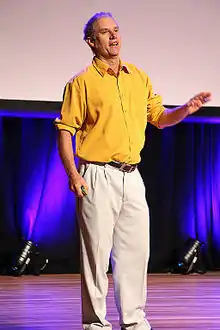Peter Hadfield (journalist)
Peter Hadfield (born 1 July 1954) is a British freelance journalist and author,[1] trained as a geologist,[2] who runs the YouTube channel Potholer54,[3] which has over 200,000 subscribers.[4]
| Peter Hadfield | |||||||
|---|---|---|---|---|---|---|---|
 Peter Hadfield speaking on "TV Tricks of the Trade" at the 2014 Australian Skeptics' Convention. | |||||||
| Personal information | |||||||
| Born | 7 January 1954 | ||||||
| Nationality | British | ||||||
| Occupation | |||||||
| YouTube information | |||||||
| Channel | |||||||
| Years active | 2007–present | ||||||
| Subscribers | 204 thousand | ||||||
| Total views | 28.16 million | ||||||
| |||||||
Updated: 5 June 2020 | |||||||
Early life and education
Hadfield has a degree in geology.[5]
Reporting career
Hadfield wrote a weekly humour column for The Mainichi Daily News (the English edition of the Japanese-language Mainichi Shimbun) while living in Japan.[6] He was The Sunday Times correspondent in Tokyo from 1988 to 1990, then wrote a regular column for the Daily Mail on life in Japan.
Later he became Tokyo correspondent for the Sunday Telegraph and U.S. News & World Report. He was also the Tokyo correspondent for New Scientist for 14 years.[7] His writing has appeared in other publications, such as the BBC News website[8], USA Today, The Guardian,[9]The Independent, The Daily Telegraph,[10] The South China Morning Post and The Lancet.
In 1991 Hadfield became Far East correspondent for Monitor Radio, and reported throughout East Asia.[11] During this period, Hadfield wrote and appeared on screen regularly as a correspondent for CNN,[12] the Australian Broadcasting Corporation (ABC), ABC News (U.S.)[13] and the Canadian Broadcasting Corporation (CBC).[1]
Hadfield's book, "Sixty Seconds that Will Change the World," about the potential implications of an earthquake in Tokyo, was published by Sidgwick & Jackson in 1991. A second revised edition was published by Tuttle in 1995 after the Kobe earthquake.[14][15]
More recently, he has contributed regularly to the CBC, NPR, and BBC radio programmes Costing The Earth, Science in Action, The World Tonight, Outlook and East Asia Today, as well as the ABC's Science Show.[7][16]
YouTube career
Hadfield, known on YouTube as "Potholer54" and "Potholer54debunks", has made videos about various scientific topics, such as the science behind global warming, age of the earth and debunking arguments used by young earth creationists to claim the earth or universe are young, and for videos on how tricks of the trade in journalism can be used to fool viewers. For example, his video about how climate change deniers have claimed that the earth has been cooling since 1998 has been featured on Boing Boing, where Maggie Koerth-Baker has called it "true skepticism at its best."[17] Hadfield has also made videos debunking the claims made by comic artist Neal Adams,[18] proponent of the Expanding Earth theory, and Christopher Monckton, 3rd Viscount Monckton of Brenchley about climate change science in public presentations; Hadfield's series on this topic is entitled "Monckton Bunkum."[19] A back-and-forth ensued, in which Monckton responded to Hadfield's video series about him on Watts Up With That?, whereupon Hadfield replied in turn. In March 2010 Hadfield penned an opinion piece on his YouTube series for The Guardian.[3]
As an example of his style of debunking, in June 2013 Hadfield revealed that a photo that was provided as evidence for a link between High Frequency Active Auroral Research Program (HAARP) and the 2004 tsunami in the first episode of the television show Conspiracy Theory with Jesse Ventura, was purchased from a commercial photographer's website.[20] The photo was introduced by the TV-show's lead investigator Raheem as a picture of the Aurora borealis. Hadfield found that the photo was described by the photographer as being of the Aurora Australis.[21]
Hadfield has stated that both sides in the global warming debate have made erroneous statements, saying, "while skeptics like Christopher Monckton and Martin Durkin fabricate a lot of their facts, many environmental activists tend to exaggerate theirs."[3]
References
- Peter Hadfield's introducing himself in the video Who I am
- Evelyn (14 May 2011). "Earthquakes and End-of-the-World Nonsense". Skepchick. Retrieved 14 October 2013.
- Hadfield, Peter (29 March 2010). "How my YouTube channel is converting climate change sceptics". The Guardian. Retrieved 14 October 2013.
- "YouTube channel belonging to Peter Hadfield – YouTube username "potholer54"".
- "Peter Hadfield addresses the recent email release". skepticalscience.com. Retrieved 26 November 2017.
- MacLaren, Don, "Pros and cons of Japan-bashing" The Mainichi Daily News, 31 October 1998
- "Fujimori charged with murder". 28 August 2001. Retrieved 9 September 2018.
- Hadfield, Peter. "Japan's earthquake will create a global financial aftershock" The Guardian, 15 March 2011
- Hadfield, Peter (2 December 2001). "Joy in Japan as princess gives birth". ISSN 0307-1235. Retrieved 9 September 2018.
- "CNN.com - Japan suspects first case of mad cow - September 10, 2001". edition.cnn.com. Retrieved 6 September 2018.
- "8 Children Dead in Japanese School Stabbing". ABC News. 6 January 2006. Retrieved 6 September 2018.
- Hadfield, Peter. "Sixty Seconds That Will Change the World: Coming Tokyo Earthquake" Amazon.com, Sixty Seconds That Will Change the World: Coming Tokyo Earthquake, Sidgwick & Jackson Ltd, 1991
- Hadfield, Peter. "The Coming Tokyo Earthquake – Sixty Seconds That Will Change the World" Amazon.com, The Coming Tokyo Earthquake – Sixty Seconds That Will Change the World, Tuttle, 1995
- Koerth-Baker, Maggie (4 November 2010). "Where climate myths come from". Boing Boing. Retrieved 16 October 2013.
- potholer54. "Expanding earth my ass". YouTube. Retrieved 25 December 2015.
- Readfearn, Graham (1 November 2012). "Climate Science Denialist Lord Monckton's IPCC "Appointment" That Wasn't". DeSmogBlog. Retrieved 14 October 2013.
- potholer54. "Conspiracy theories conspiracy". YouTube. Retrieved 25 December 2015.
- "Aurora Australis by David Miller". Posters-wanted.com, visited on 14 June 2014
External links
- Peter Hadfield's YouTube channel